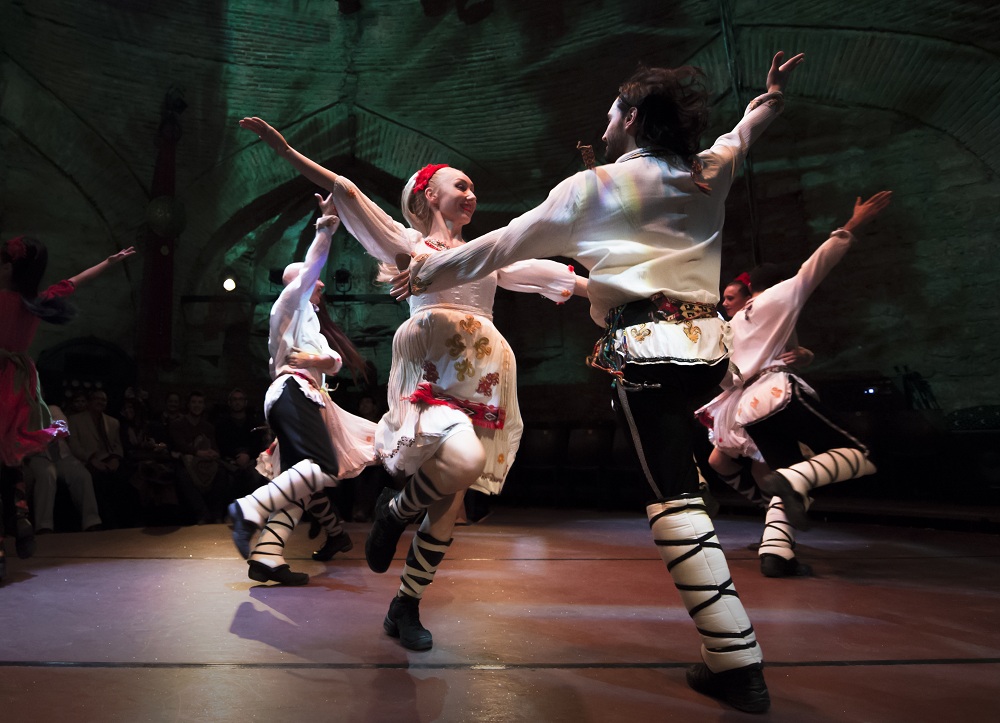Spanning Europe and Asia, at the heart of Turkey’s magic are its eclecticism and plurality. This summer I visited Turkey for the second time, and spent an evening watching whirling Dervish and traditional folk dances at Hodjapasha, where I got to see this eclecticism embodied.
I first visited Turkey around 20 years ago and saw the Dervish sema dance ritual then in a strange cellar-like venue with domed ceilings of rough bricks painted white and dark, varnish stained wooden furniture. I remember being interested in the ceremony, but not really understanding it, and it didn’t go much further than that. Twenty years on, and having read the poetry of Rumi and Hafez, the novel “Forty Rules of Love” by Elif Shafak about the transformative friendship between Rumi the Dervish monk Shams, and having had some experience with Sufi spiritual communities, I was a little bit more ready to receive and appreciate this mesmerising ritual.
The sema begins with sung prayer and music before the dancers enter, kneel in prayer, then move into the central floor space and slowly start to spin. Beginning with their arms crossed over their chests and their heads gently tilted to one side, as they rotate, their arms begin to unravel, elbows rising, arms unfolding outwards and upwards until they are extended with one hand facing upwards towards the sky and the other down to the earth. As their arms unfurl, so do their skirts, gently lifting as they spin, rising out and rippling and undulating as they turn. In this position they spin steadily in place, the left foot planted on the ground as the right heel-ball-toes to push them around in a complete turn, then after a few minutes, then begin to orbit the space in a counter clockwise direction.
Then gradually they begin to slow down, drawing their arms back in, their skirts lowering, as the return to a stationary standing position. This part of the ceremony repeats a number of times, the pattern remaining exactly the same, the pace of the spinning increasing with each repetition as they go through a process of rebirth, and embodiment of shedding their ego. The sight is hypnotic, with layers of whirling skirts, arms, bodies on their own orbit and bodies orbiting the space. Watching them, you feel a sense of calm in your own stillness relative to their movement.
On the same evening that I saw this show I stayed to watch a display of Turkish folk dances. While the show was light-hearted in comparison, the dances themselves were highly eclectic and fascinating to watch.
The show included male and female belly dancing, which are performed separately. I’ve done belly dancing before, and have some basic familiarity with the moves, but while I’d read about the male dance I’d never seen it. What was interesting was that both versions were identical in all but their energy: the men’s dance involved exactly the same rolling, shimmying, undulating sensuality as the women’s dance, but the male energy was more powerful and the female energy more delicate. Ultimately, what both versions share is a celebration of the body in its energy and vibrancy!
There were other dances that the male and female dancers performed separately. One female dance included the graceful use of fans, reminiscent of East Asian dances, while in another the women wore elaborate candelabras wrapped around their turbans, albeit lit with electric candles. They moved with slow, controlled undulations, performing feats such as sinking to the floor then rising up again, all presumably originally executed while not letting the candles go out or spilling a drop of wax. I’ve no idea if the dance was authentic, but it was fascinating.
The men’s dances included Zeibek, with its high leaps and kicks, punctuated with low dips tapping a single knee to the ground; powerful, energetic and vibrant, it’s a clear embodiment of masculine energy. Later, a solo male dancer performed a fire dance, and another a contemporary take on the dervish ritual in which the inner struggle of the dancer to cast off their ego was seemingly represented in the lifting and removal of the skirt.
Men and women also danced together, performing typical folk dances with joyful stepping patterns, low kicks and spins, hands on hips or arms raised high, couples circling one another or larger groups forming circles and lines. While varied in form, these dances were simple, energetic and vibrant representations of fishing, harvests and courtship, and offered embodied celebrations of traditional life.
What characterised the dances and the evening was the huge variety in the music and movements: the different permutations of the folk and traditional dances, and of course the Sufi sema. Whether intentional or not, the variety made the spectator aware of Turkey’s thousands of years positioned right where it is, between Europe and Asia. Turkey must have had visitors and settlers from all over the world meeting and interacting on its streets, people from all walks of life and all levels of wealth. It’s hard to avoid cliches like “vibrant” and “exotic” in the literal sense meaning things coming from far away. Similar to places like Cordoba in Spain in the 12th Century, 16th Century Lisbon or London, Turkey must always have been full of people from elsewhere, making music, singing, dancing, cooking, and trading. There must have been prejudice from some towards others, but also curiosity. Visiting the bazaars in Turkey and seeing the spices, teas, sweets, fabrics, jewellery and other goods on offer, so similar to what would have been on sale there for hundreds or thousands of years, albeit arriving by a very different journey. Turkey is a meeting point and place of exchange, with varied and eclectic tastes and flavours.

